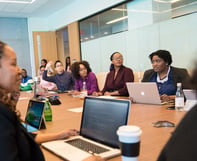Published on
Taking Innovation to Scale: Growing Makers for the STEM Economy

The California Community Colleges are answering the call for a more skilled, creative and innovative workforce by growing a statewide system of physical spaces designed to foster innovation in students and their education.
By building a network of campus makerspaces—community hubs with tools students can use to create—they will help engage more students in science, technology, engineering and mathematics and now increasingly arts (STEM/STEAM), and train a workforce for the future at a scale never before embraced by higher education.
Our New Economy
The emerging global economy is increasingly reliant on innovation and creativity, with knowledge-based jobs taking a growing share of the labor market.[1] Reflecting this shift, California’s economy has surged to be the sixth largest in the world, with a boost many economists attribute to high-tech booms and creative work throughout the state.[2]
Per a recent study, an estimated 47 percent of all U.S. occupations are potentially automatable in the next several decades.[3] Advances in technology, global connectivity, and new media are reshaping how we think about work, and compelling us to consider what skills are uniquely human.[4] These will be the most valuable skills to develop for future jobs.
Necessary workplace skills are evolving and California needs to keep pace with workforce training to stay competitive and to fill middle- and higher-skilled jobs that pay higher wages.[5] Of the occupations studied above, some of the most resilient to automation were STEM-based, requiring high degrees of creative skill, critical thinking and problem solving.[3] STEM training goes beyond preparing workers for future jobs; STEM graduates earn more, boasting a 10-30 percent higher mean income than those with non-STEM degrees over the past 45 years.[6]
In today’s quickly changing technology environment, is having the technical chops enough? New data shows that 40 percent of global employers report difficulty filling jobs—such as skilled trades, engineers, technicians, and IT staff—due to a lack of talent.[7] This “skills gap” has become a controversial idea in part because there are applicants who have math and science literacy, yet jobs which require these skills are still going unfilled.[8] The continued difficulty employers report in filling jobs suggests the skills gap is not simply a lack of basic STEM skills in the workforce, but too few workers able to keep pace with constantly changing technologies.[9]
As former U.S. Secretary of Education Richard Riley has said, “We are currently preparing students for jobs that don’t yet exist, using technologies that haven’t been invented, in order to solve problems we don’t even know are problems yet.” [11] California’s economy needs a workforce that is literate in the technical skills required to perform a job in a STEM field and is adaptable, ready for lifelong learning, with creative problem-solving skills fit for the future.
The Maker Movement and STEM Education
The Maker Movement as it is known today began in 2005 with the founding of Make: magazine. It was enthusiastically nurtured with the creation and growing attendance of maker fairs around the globe, and sustained through continually shared documentation of what makers make.[12] The real magic happens in community-based places—makerspaces—where makers have access to space, support and equipment to create and collaborate. While many models of makerspaces exist, they frequently feature a variety of equipment such as 3D printers, laser cutters, basic electronics equipment, vinyl cutters, computer numerical control (CNC) routers and millers. These tools, and the community support central to a makerspace, facilitate quick prototyping of innovative new designs, cross-pollination of ideas, and peer-to-peer teaching of valuable skills and techniques.
The makerspace has emerged as a place rich not only in exciting possibilities for innovation and collaboration, but also in significant shifts in the formal learning environment. Through making, students are allowed and not afraid to fail, experimenting with concepts as they create, rather than listening for theories as they sit. Making offers complementary modes of learning to the traditional classroom, helping participants develop skills that differ from those learned while completing traditional coursework.
One key to makerspace impact and success is an environment that facilitates the practice of the “4 Cs” of 21st-century skills: Creative thinking, Critical thinking, Collaboration and Communication. These soft skills are in demand by employers and transcend any particular industry. Students with these portable skills will find themselves resilient in the STEM economy as technologies and technical knowledge evolve at an ever-faster rate.
The global momentum of the Maker movement is building, and the United States has embraced it fully. In 2014, President Obama launched the Nation of Makers initiative, which called for more access to new technologies for students, entrepreneurs and citizens.[13] Since then, the President has issued a challenge to creative thinkers, innovators and entrepreneurs across the country to develop novel platforms, ideas and approaches across disciplines to solve some of our nation’s biggest problems.
Recognizing the transformative potential of the Maker Movement, the California Community College system has joined renowned institutions of higher learning such as the University of California, Stanford University and the Massachusetts Institute of Technology—which have implemented their own makerspaces—in answering the call to join the Maker Movement.
California Community Colleges Will Educate and Train a New Workforce
The broad accessibility of making resonates with the California Community Colleges’ mission of serving students with a wide range of ages, employment experience and backgrounds. The California Community College Chancellor’s Office worked with the California Council on Science and Technology (CCST) to tackle the challenge of bringing together traditional academic institutions with Maker culture. The result of this partnership was a report by CCST, Promoting Engagement of the California Community Colleges with the Maker Movement, that serves as a playbook for growing a statewide network of makerspaces intended to enhance students’ education and workforce training.[14] The report includes a timeline, key network characteristics, goals and structure of the network, a range of makerspace models, and a checklist for moving forward.
Beginning this year, California Community Colleges is investing $17 million to better connect its institutions throughout the state into the Maker Movement, becoming the first higher education system to bring this civic model to scale as part of its focus on a key initiative, Doing What MATTERS for Jobs and the Economy. Of its 113 campuses, more than half participated in the earliest stages of the initiative, and 35 California Community Colleges are advancing plans to establish new or expand existing makerspaces to operate over the next 3 years.
The network of makerspaces is forming under the California Community Colleges maker initiative, which is already providing guidance and professional development for developing not only the spaces themselves, but also the tools to incorporate the makerspaces into STEM curricula and into their local economies. Plans are underway to develop makerspace-related, work-based learning opportunities that will not only provide important experience to students, but also help connect campus makerspaces to local businesses. Representatives from the emerging makerspace network have begun connecting with other academic institutions as well, recently presenting California’s model to a global audience at the first International Symposium on Academic Makerspaces at MIT in Boston, Massachusetts.[15]
Through its statewide network of makerspaces, California Community Colleges aims to further connect community colleges to their regional economies, bring its diverse student body into better position to fill the STEM careers of the expanding innovation economy, and offer graduates with skills that will allow them to confront the issues of tomorrow.
– – – –
References
[1] World Bank. 2003. “Chapter 1: The Knowledge Economy and the Changing Needs of the Labor Market.” In: Lifelong learning in the global knowledge economy: challenges for developing countries. Washington, D.C.: The World Bank. http://siteresources.worldbank.org/INTLL/Resources/Lifelong-Learning-in-the-Global-Knowledge-Economy/chapter1.pdf, accessed January 31, 2017.
[2] Dale Kasler, “California economy surges to No. 6 in global rankings,” The Sacramento Bee, June 14, 2016. http://www.sacbee.com/news/business/article83780667.html, accessed January 31, 2017.
[3] Frey, C., and Osborne, M. 2013. The Future of Employment: How Susceptible Are Jobs to Computerisation? Technical Report, Oxford Martin School, University of Oxford, Oxford, UK.
http://www.oxfordmartin.ox.ac.uk/downloads/academic/The_Future_of_Employment.pdf, accessed January 31, 2017.
[4]Anna Davies, Devin Fidler, Marina Gorbis. Institute for the Future. 2011. Future Work Skills 2020. http://www.iftf.org/uploads/media/SR-1382A_UPRI_future_work_skills_sm.pdf, accessed February 4, 2017.
[5] CAFWD and California Stewardship Network. 2016. California Economic Summit Playbook. https://cafwd.app.box.com/s/yr3y3yjb7cc5cz3w503gxkb47bvcifdn, accessed February 4, 2017.
[6] Tony Carnevale and Nicole Smith. “Long Road out of (Olive Garden of) Eden.” University Ventures Letters, Volume VI, #5. March 4, 2016. http://universityventures.com/publications.php?title=long-road-out-of-olive-garden-of-eden, accessed January 31, 2017.
[7] ManpowerGroup, 2016/2017 Global Talent Shortage Survey, Press Release. http://www.manpowergroup.com/wps/wcm/connect/8ccb11cb-1ad4-4634-84ea-1656ee74b3ed/GlobalTalentShortageSurvey-PressRelease.pdf?MOD=AJPERES&ContentCache=NONE&, accessed January 31, 2017.
[8] The Editorial Board, “Don’t Blame the Work Force,” The New York Times, June 15, 2013. http://www.nytimes.com/2013/06/16/opinion/sunday/dont-blame-the-work-force.html?_r=0, accessed January 31, 2017.
[9] James Bessen, “Employers Aren’t Just Whining—The ‘Skills Gap’ Is Real,” Harvard Business Review, August 25, 2014. https://hbr.org/2014/08/employers-arent-just-whining-the-skills-gap-is-real, accessed January 31, 2017.
[10] ManpowerGroup, “2016/2017 Global Talent Shortage Survey.” Press Release, October 18, 2016. http://www.manpowergroup.com/wps/wcm/connect/8ccb11cb-1ad4-4634-84ea-1656ee74b3ed/GlobalTalentShortageSurvey-PressRelease.pdf?MOD=AJPERES&ContentCache=NONE&, accessed January 31, 2017.
[11] Richard Riley, quoted in: Steve Gunderson, Jones Roberts, and Kathryn Scanland.
The Jobs Revolution: Changing How America Works, 2004. Pennsylvania State University. p. 106
[12] Zara Stone, “The Maker Movement Is Taking Over America. Here’s How,” The Hustle, December 11, 2015, The Hustle on the Web, accessed October 28, 2016.
[13] The White House. “President Obama to Host First-Ever White House Maker Faire,” White House Press Release, June 18, 2014. https://obamawhitehouse.archives.gov/the-press-office/2014/06/18/fact-sheet-president-obama-host-first-ever-white-house-maker-faire, accessed January 31, 2017.
[14] Laura Feinstein, Daniel DeCillis and Laurie Harris. California Council on Science and Technology. Promoting Engagement of California Community Colleges with the Maker Movement. Sacramento, California. April 2016. Available online. http://ccst.us/publications/2016/2016makers.php, accessed January 31, 2017.
[15] Pepper-Kittredge, Carol and DeVoe, Paul. 2016. “Creating a Network of Community Colleges with Makerspaces: California’s CCC Maker Model,” In: Proceedings of the 1st International Symposium on Academic Makerspaces, p. 221-224. https://project-manus.mit.edu/home/conference, accessed January 31, 2017.
Author Perspective: Administrator
Author Perspective: Community College



